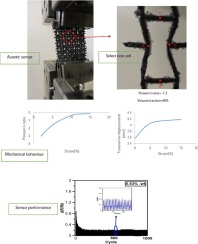Sensors and Actuators A: Physical ( IF 4.1 ) Pub Date : 2020-03-03 , DOI: 10.1016/j.sna.2020.111939 Bahman Taherkhani , Mohammad Bagher Azizkhani , Javad Kadkhodapour , Ali Pourkamali Anaraki , Shima Rastgordani

|
An auxetic structure as a substrate material in sensor applications improves sensitivity performance due to lateral expansion under tensile loading. The presented stretchable, highly sensitive at-low-strain piezoresistive sensor was manufactured by mixing the silicone rubber and chopped carbon fibers in an auxetic re-entrant structure form. Auxetic re-entrant die was printed by using a 3D printing technique. The main feature of this sensor is the high sensitivity for strains lower than 6%, in which previous sensors could not recognize this range of strain well. In order to justify the excellent performance of the sensor, the deformation modes of the auxetic re-entrant structures were investigated and also connected to piezoresistive sensitivity. The shifting strain is defined as strain value, where the Poisson’s ratio of structure shifts from negative to positive Poisson’s ratio. Our study revealed that auxetic sensors have excellent sensitivity performance until the shifting strain due to having negative Poisson’s ratio, and after that, their sensitivity performance is going to be weak due to having positive Poisson’s ratio. In the present work, silicone rubber as the substrate material was used. This is a very soft material and made it possible to have low shifting strain resulting in perfect sensitivity performance for low-strain applications. The presented sensor has applications in many fields which are in low-strain conditions such as measuring the Vocal Cord Dysfunction (VCD), wrist pulse, or even earth vibration.
中文翻译:

基于硅/碳纤维的高度灵敏,压阻,低应变传感器
由于在拉伸载荷下的横向膨胀,在传感器应用中作为基材材料的膨胀结构提高了灵敏度性能。提出的可拉伸,高灵敏度的低应变压阻传感器是通过将硅橡胶和切碎的碳纤维以膨胀凹形结构形式混合而制成的。使用3D打印技术来印刷助熔凹模。该传感器的主要特征是对低于6%的应变具有高灵敏度,而以前的传感器无法很好地识别此范围的应变。为了证明传感器的优异性能,研究了膨胀凹腔结构的变形模式,并将其与压阻灵敏度联系在一起。位移应变定义为应变值,泊松结构比率从负泊松比率变为正泊松比率。我们的研究表明,由于泊松比为负,拉力传感器在位移应变之前具有出色的灵敏度性能,此后,由于泊松比为正,其灵敏度性能将变弱。在本工作中,使用硅橡胶作为基材。这是一种非常柔软的材料,并可能具有较低的位移应变,从而为低应变应用提供了完美的灵敏度性能。提出的传感器在低应变条件下的许多领域都有应用,例如测量声带功能障碍(VCD),手腕脉搏甚至是地面振动。我们的研究表明,由于泊松比为负,拉力传感器在位移应变之前具有出色的灵敏度性能,此后,由于泊松比为正,其灵敏度性能将变弱。在本工作中,使用硅橡胶作为基材。这是一种非常柔软的材料,并可能具有较低的位移应变,从而为低应变应用提供了完美的灵敏度性能。提出的传感器在低应变条件下的许多领域都有应用,例如测量声带功能障碍(VCD),手腕脉搏甚至是地面振动。我们的研究表明,由于泊松比为负,拉力传感器在位移应变之前具有出色的灵敏度性能,此后,由于泊松比为正,其灵敏度性能将变弱。在本工作中,使用硅橡胶作为基材。这是一种非常柔软的材料,并可能具有较低的位移应变,从而为低应变应用提供了完美的灵敏度性能。提出的传感器在低应变条件下的许多领域都有应用,例如测量声带功能障碍(VCD),手腕脉搏甚至是地面振动。使用硅橡胶作为基材。这是一种非常柔软的材料,并可能具有较低的位移应变,从而为低应变应用提供了完美的灵敏度性能。提出的传感器在低应变条件下的许多领域都有应用,例如测量声带功能障碍(VCD),手腕脉搏甚至是地面振动。使用硅橡胶作为基材。这是一种非常柔软的材料,并可能具有较低的位移应变,从而为低应变应用提供了完美的灵敏度性能。提出的传感器在低应变条件下的许多领域都有应用,例如测量声带功能障碍(VCD),手腕脉搏甚至是地面振动。











































 京公网安备 11010802027423号
京公网安备 11010802027423号